
views
Memorizing Key Information

Start by rereading or rewriting your notes over and over again. Refresh the information in your head as many times as you can. You can read aloud to yourself or rewrite your notes in your own words. Go slow and don’t rush through it—skimming will only waste precious study time. If you prefer to rewrite your notes, jot them down in a different format—outlines, charts, and idea-maps will help you categorize information and draw valuable links between bits of material.
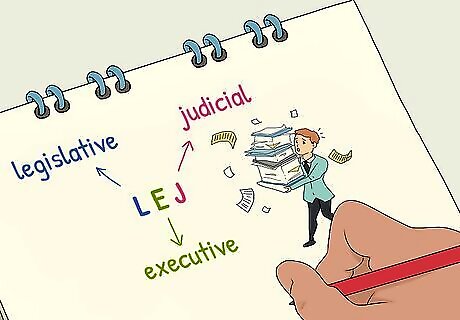
Create acronyms to help you memorize names and concepts. Take the first letters of key terms and organize them into a word or something you can remember. Try to make the acronym something related to the topic or something you can picture in your mind to kickstart your memory. For example, you might remember the 3 branches of government by the acronym "LEJ" (legislative, executive, judicial) and recall the acronym by picturing a government executive carrying a ledger (as it sounds similar to the acronym). In math, you could use the acronym PEMDAS (parenthesis, exponents, multiplication, division, addition, subtraction) to remember the order of operations when you're solving an equation.
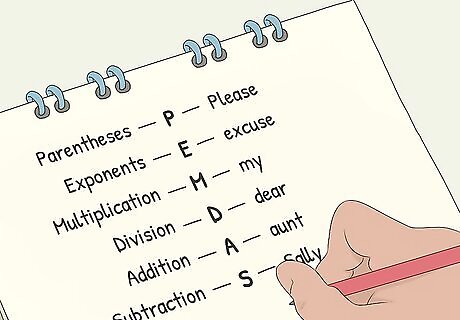
Use word association to grasp meanings and key ideas. Look at the words themselves to give you a clue on how to remember their meanings. You can use a prefix or suffix of the word (the beginning or end) to jog your memory or a sequence of letters inside the word. For example, you might remember the difference between latitude and longitude by taking the first 3 letters of latitude (“LAT”) and associating that with the word “flat” (latitudinal lines lay flat on a map).
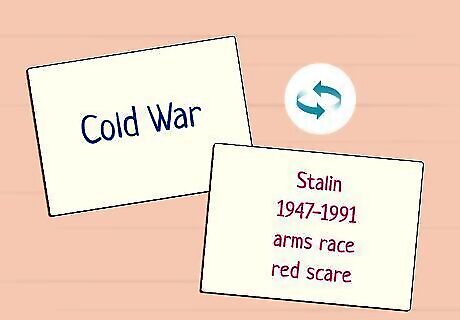
Make flashcards to help you define and link key terms, names, and ideas. Write a word or phrase on the blank side of a notecard and write any definitions, important facts, or associated ideas on the back. Shuffle the cards each time you study to give yourself a challenge. For example, you might write "Cold War" on one side and "Stalin, 1947-1991, arms race, red scare" on the back. Flashcards are an excellent tool to practice your recall abilities, which is a major skill when it comes to taking a multiple-choice test. You could also make a "cheat sheet" with the important facts, formulas, and concepts from your notes. Study these, paying special attention to the relationships between the concepts. Then, go back over your notes to figure out how more specific details fit into the bigger picture.

Come up with short rhymes to memorize important information. Create a simple rhyming phrase that contains any key information, including special dates, facts, and names (if applicable). Keep it short and simple so you can repeat it in your head quickly and as often as you like. Don’t stress about making a perfect rhyme—just make it close enough to where the sound of the words can jog your memory. For instance:"In 1492 Columbus sailed the ocean blue" or "'59 was the date Alaska and Hawaii became new states."

Put relevant information into a familiar song or jingle. Take a simple tune that doesn't require much thought to remember (like the "Hot Crossed Buns" song or "Mary Had a Little Lamb") and replace the words with some key dates, names, or ideas you're trying to memorize. The catchier it is, the better! For example, you might loosely put the words "Seneca Falls, Stanton and Mott, 1848, they wanted suffrage for all" to the tune of "Hot Crossed Buns.” Don't worry about making the syllables match up to the original tunes, just focus on fitting key information into the jingle.
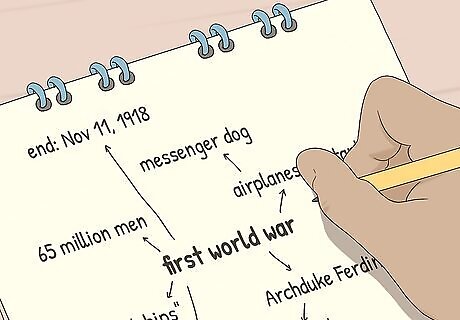
Write a list of all the relevant words and ideas you don't quite know. Go through your notes, the textbook, or handouts and make a list of any keywords that you're iffy about. Write a short definition next to each one in your own words so you can get a better grasp on their meaning. Some teachers like to throw curveballs on exams, so be prepared to impress them by knowing even the most obscure terms or ideas!
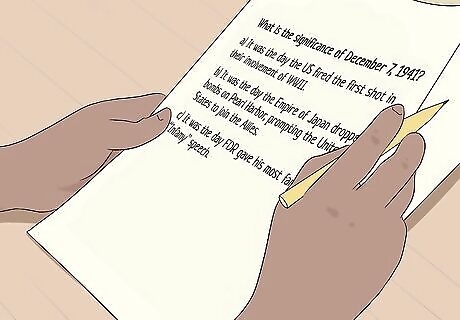
Quiz yourself by writing your own multiple-choice questions. Create your own questions about the material, focusing on key dates, names, places, and ideas. Once you have 10 to 20 questions, set it aside and test yourself later on to see what you remember and what you need to focus more on. It can be hard to come up with questions, so base them around the “who, what, when, where, and why” of the material. Read over your study materials carefully, and try to think of questions the teacher might ask based on your notes. Consider asking a friend to make their own sample test so you can trade. You can also look up short online quizzes related to the material. A good example question might be: What is the significance of December 7, 1941?a) It was the day the US fired the first shot in their involvement of WWII.b) It was the day the Empire of Japan dropped bombs on Pearl Harbor, prompting the United States to join the Allies.c) It was the day FDR gave his most famous “Infamy” speech. Reader Poll: We asked 155 wikiHow readers, and 67% of them agreed that the best way to prepare for a test is to take practice tests. [Take Poll]
Creating Good Study Habits

Start studying at least a few days to a week before the test. Start studying at least a few days to a week before the exam so the information has time to percolate in your mind. Gauge how early you should start based on how much information is on the test. For instance, start studying 2 weeks before final exams that cover an entire semester of material. For midterms or quarter-exams, starting a few days to a week ahead of the test date should be enough time. Getting a head start will also lower your stress levels and give you adequate time to rest your brain between study sessions.

Take short breaks between 30-minute to hour-long study sessions. Set a timer for 30 minutes or 1 hour when you sit down and focus on nothing but studying during that time. Make a schedule that allows you to go outside, get some exercise, or turn your brain off for 15 to 30 minutes between study times. These gaps can reboot your energy, giving your eyes and your brain a much-deserved rest. For instance, you might schedule the afternoon like this:3:00 - 4:00 PM Review and rewrite notes4:00 - 4:15 PM Brisk walk around the block4:15 - 4:45 PM Study with flashcards4:45 - 5:00 PM Snack break5:00 - 6:00 PM Take online practice test
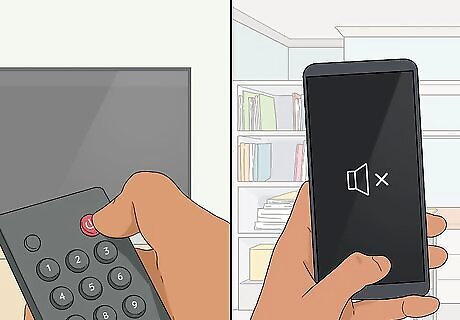
Put away any and all distractions. Put away your phone, turn off the TV, avoid places where others might distract you, and don't listen to music while you study. Save those activities for your scheduled break times. If you can’t avoid distractions, do your best to deal with them by wearing noise-cancellation headphones or moving your study area to a quieter place. However, it's okay if you focus better with background music or some noise going on—do what works best for you! If you prefer to study in a public place but don’t want any friends distracting you, kindly let them know you’ll catch up with them on your next short break. You can also ask them to study with you—just don’t distract each other!

Choose a study area that’s as clean, organized, and clutter-free as possible. Clutter affects your ability to focus, so make sure your study space is clean and organized. Keep all your supplies like pens, paper, textbooks, and handouts right where you need them so you don’t waste precious study time looking for things. However, don’t use cleaning as an excuse to procrastinate! If you need to study right away and have a disorderly room, go to a library, coffee shop, or somewhere else where you can be in a clean, comfortable environment.

Make sure you’re sitting in a comfortable chair with good posture. Avoid sitting down to study in a hard, uncomfortable chair with a super-straight back. You don’t want to be breaking your focus to reposition yourself every so often. Use pillows or ergonomic cushions to keep your body upright, aligned, and comfortable. However, too much comfort can make you feel sleepy, so stay away from a cushy armchair if you’re already feeling beat. If your legs or butt is prone to falling asleep while you’re sitting, consider using a standing desk instead.
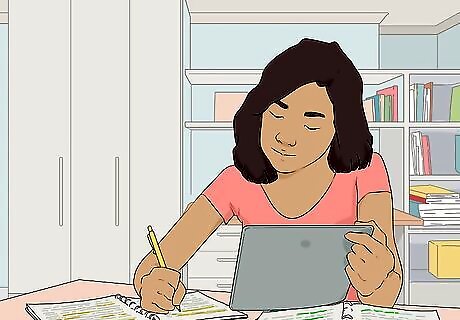
Split the load of material into sections by source or by topic. Dedicate 1 day to studying course material from the textbook and another day to studying material from your lecture notes or other supplementary materials. Or, you can split it up by the particular topic within the subject. This will help you compartmentalize the information and keep your study sessions focused and manageable. If your teacher emphasized one source over another, study that one first so you have more time with it. For instance, for a world history course, might study the main events of the Korean War one day and the main events of the Cold War the next. As another example, if you’re studying a foreign language, you might study basic vocabulary during 1 session and conjugations during another.

Over-learn the information if you get anxious during tests. Once you have a good grasp on the material, keep studying! Test anxiety can make it hard to recall the information, so the more it's cemented in your brain, the better! Once you’ve mastered some topics, feel free to speed-study those and focus on the ones you don’t feel as confident about.

















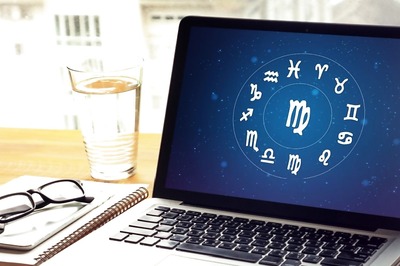


Comments
0 comment